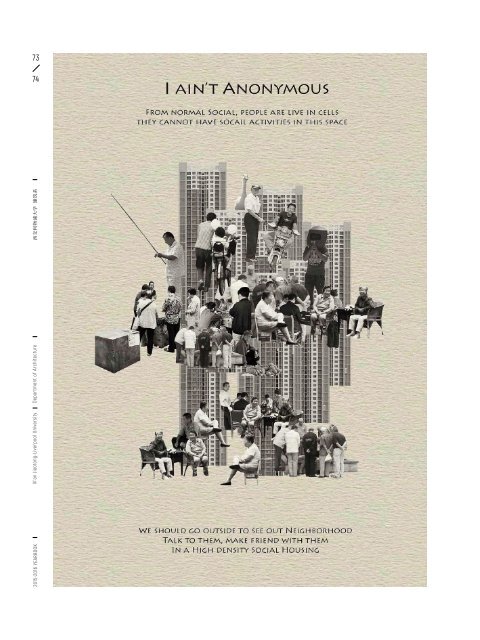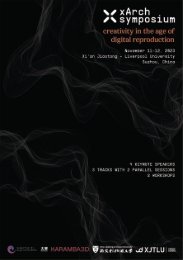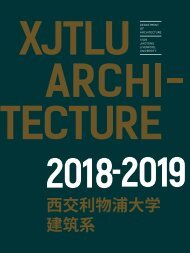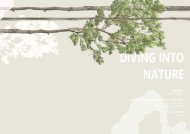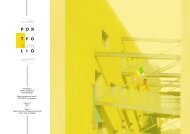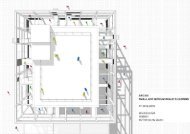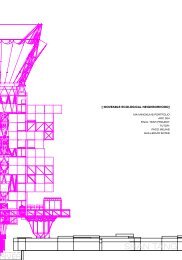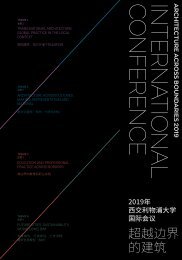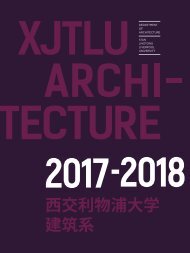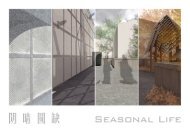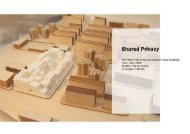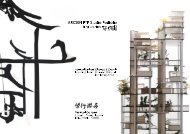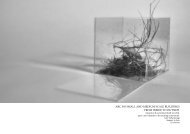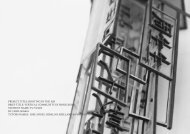YEARBOOK 2015 - 2016 | XJTLU DEPARTMENT OF ARCHITECTURE
The third edition of the yearbook of the Department of Architecture at Xi'an Jiaotong-Liverpool University presents student works created during the academic year 2015 - 2016. The yearbook exemplifies the new model for Chinese architectural education for which the department was commended by the Royal Institute of British Architects (RIBA) in their validation report for the Bachelor in Architecture. It is thus also a showcase of the creative culture that has guided our students in taking first steps to successful international careers as responsible and creative architectural designers.
The third edition of the yearbook of the Department of Architecture at Xi'an Jiaotong-Liverpool University presents student works created during the academic year 2015 - 2016. The yearbook exemplifies the new model for Chinese architectural education for which the department was commended by the Royal Institute of British Architects (RIBA) in their validation report for the Bachelor in Architecture. It is thus also a showcase of the creative culture that has guided our students in taking first steps to successful international careers as responsible and creative architectural designers.
Create successful ePaper yourself
Turn your PDF publications into a flip-book with our unique Google optimized e-Paper software.
73<br />
74<br />
ARC205<br />
Design Studio<br />
Design and Building Typology<br />
<strong>2015</strong>-<strong>2016</strong> <strong>YEARBOOK</strong> Xi’an Jiaotong-Liverpool University Department of Architecture 西 交 利 物 浦 大 学 建 筑 系<br />
Level 2<br />
( Year 3 | Semester 1 )<br />
Module Credits<br />
10<br />
Module Leader<br />
Aleksandra Raonic<br />
Teaching Team<br />
Ganna Andrianova<br />
Yiping Dong<br />
Edward Farrell<br />
Austin Williams<br />
Number of Students<br />
55<br />
Guest Critics<br />
Lin Bing<br />
( OLI Architecture<br />
Shanghai | New York )<br />
Living in a Dense City: High-Density Living =<br />
High-Quality Living<br />
This studio asks students to generate new models and typologies for collective<br />
housing for people that are currently being relocated from their<br />
original living environments (rural or suburban areas) to the city. In<br />
short, it calls for new models of Relocation Housing, set on a site located<br />
on the south side of the dense and vibrant old Suzhou centre.<br />
The studio brief is user-focused, and anticipates a user-driven design<br />
process that requires the students to clearly define a user group typology,<br />
according to which different relocation housing types will be developed<br />
to fit the users’ specific needs. A detailed portrayal of users, their activities,<br />
needs and desires will help envision scenarios which can be both<br />
visionary and realistic.<br />
Students begin with the development of a ‘basic living unit’ that can be<br />
adapted to a variety of different users’ demands and living scenarios.<br />
Using different spatial operations (multiplying, clustering, scaling), students<br />
achieve variability of spatial configurations on both architectural<br />
scale as on the scale of an urban block configuration. By operating on a<br />
range of scales, while exploiting issues of grounding, verticality and site<br />
constraints, students are able to achieve higher levels of programmatic<br />
and social diversity, and to test issues of proximity, accessibility, light,<br />
and connectivity on a single unit as well as on the larger number of units<br />
(assemblies), or on parts of the block configuration.<br />
This studio invites students to use experimental and innovative design<br />
approaches in developing new models for high-quality, high-density<br />
living in a relocation housing development that successfully negotiates<br />
between collective and individual interests, between public and private.<br />
Final designs seek to offer a new urban form that has the capacity to<br />
catalyse vibrant and exciting opportunities for dense and intensive city<br />
life in a contemporary Chinese context.<br />
Level 02 – Year 3<br />
B Eng Architecture Programme


